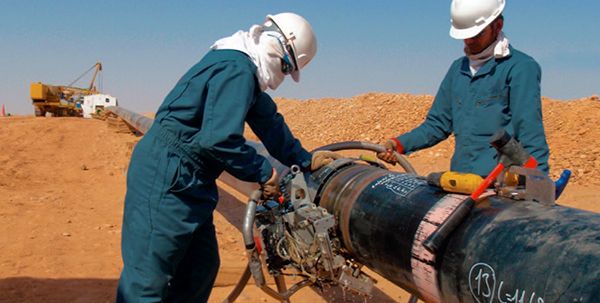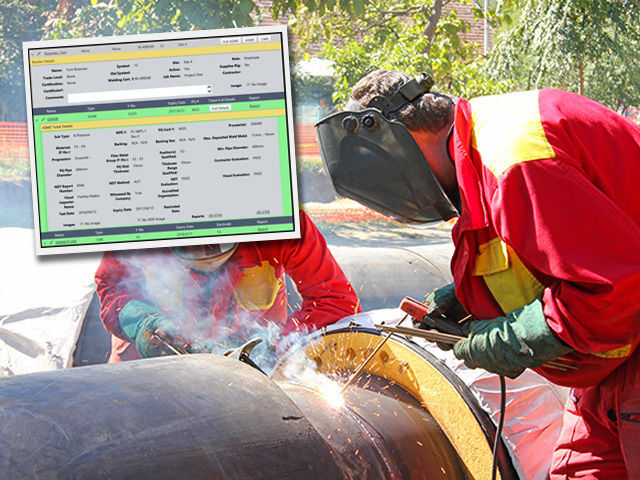Quality Control Assured: Specialist Pipeline Welding Inspection Services
Taking Full Advantage Of Efficiency: Pipeline Welding Inspection Best Practices
In the realm of pipe building, the integrity and safety of bonded joints are paramount. Making certain that welding assessments are conducted successfully and successfully can considerably influence the overall top quality of the job. By implementing finest practices for pipe welding evaluation, companies can improve processes, minimize mistakes, and enhance job timelines. From utilizing innovative technology to developing rigorous assessment protocols, there are many strategies that can be utilized to make the most of performance in this crucial facet of pipeline building - Pipeline Welding Inspection. The thorough attention to information called for in welding evaluation holds the crucial to the lasting sturdiness and integrity of the pipelines, making it a subject of utmost significance in the sector.

Significance of Reliable Welding Inspections
Efficient welding evaluations play a critical role in guaranteeing the structural honesty and safety and security of pipelines. Correct examinations are important to determine any kind of defects, interruptions, or blemishes in the bonded joints that can endanger the total honesty of the pipe system. By performing extensive assessments, assessors can find concerns beforehand, protecting against possible leakages, tears, or failures that could have major environmental and safety effects.
Precise and timely welding evaluations also help in maintaining conformity with sector requirements and policies. Complying with these standards is not just a legal requirement but additionally an essential procedure to ensure the reliability and longevity of the pipes. Additionally, effective evaluations can contribute to set you back savings by minimizing the demand for expensive repair work or replacements because of welding problems that can have been stopped or fixed during the examination process.
Using Technology for Examinations
To enhance the efficiency and precision of pipeline welding inspections, the combination of advanced modern technologies has become increasingly vital in ensuring accurate and extensive analyses of welded joints. Using modern technology for assessments supplies many benefits, including boosted effectiveness, boosted accuracy, and improved precaution. One of the crucial technical developments in pipeline welding examinations is using automated ultrasonic testing (AUT) systems. These systems can scan welds promptly and properly, offering in-depth information on possible issues or issues within the weld joint. Additionally, remote visual examination (RVI) tools such as robot spiders outfitted with electronic cameras allow inspectors to access and assess difficult-to-reach areas without the requirement for substantial disassembly or hand-operated treatment. The execution of electronic systems for information evaluation and reporting enhances the evaluation process, enabling real-time information analysis and smooth documents. By welcoming these technical solutions, pipeline welding evaluations can be performed better, causing higher high quality welds, improved total safety and security, and lowered task timelines.
Developing Clear Inspection Procedures
Developing clear evaluation procedures is necessary for guaranteeing uniformity and dependability in the pipe welding evaluation procedure. These methods serve as a collection of standards that outline the certain actions, criteria, and techniques to be adhered to during evaluations. By plainly specifying the inspection procedures, all examiners associated with the procedure can recognize their roles and obligations, bring about a more efficient and standardized assessment operations.

Regular review and updates to the evaluation methods are this content likewise vital to adjust to altering sector criteria and needs. By continually refining and boosting the methods based web link upon feedback and lessons found out, pipeline welding assessments can promote the best requirements and regulative conformity.
Training and Qualifications for Assessors

Educating and certifications for assessors are paramount in making sure the competence and effectiveness of individuals tasked with overseeing pipe welding processes - Pipeline Welding Inspection. Properly educated examiners possess the essential understanding and skills to properly examine weld quality, adherence to welding treatments, and compliance with sector standards and regulations
Qualifications, such as those provided by the American Welding Culture (AWS) or the American Petroleum Institute (API), confirm an examiner's knowledge and capacity to carry out inspections to the highest requirements. These accreditations often need strenuous training, evaluations, and recurring expert growth to make sure that assessors stay present with the current improvements in welding technology and inspection methods.
In addition to formal accreditations, continuous training programs play an essential duty in enhancing inspectors' abilities. These programs cover a variety of topics, consisting of welding procedures, defect detection, security procedures, and pertinent codes and standards (Pipeline Welding Inspection). By purchasing detailed training and qualifications for assessors, companies can support the stability of their pipeline welding jobs and alleviate the risks related to low-grade welds
Continual Improvement in Evaluation Processes
Building upon the structure of qualified and certified examiners, constant enhancement in assessment procedures is necessary for making certain the recurring quality and compliance of pipe welding procedures. By applying a system of continual renovation, pipe welding assessment processes can develop to fulfill the transforming needs of the market, technological developments, and regulatory requirements. This entails consistently evaluating and evaluating inspection techniques, devices, and procedures to identify locations for enhancement.
One secret element of continuous renovation in assessment processes is responses. Gathering input from inspectors, welders, designers, and other stakeholders enables an extensive assessment of existing methods and the recognition of prospective areas for enhancement. Additionally, leveraging analytics and data can supply useful insights right into the effectiveness of examination processes, making it possible for notified decision-making for optimization.
In addition, investing in training and growth programs for inspectors can guarantee that they are equipped with the most recent knowledge and skills to execute their responsibilities successfully. Continuous enhancement is a vibrant process that needs commitment and commitment from all stakeholders to drive excellence in pipe welding inspection methods.
Verdict
Finally, making the most of efficiency in pipeline welding evaluations is essential for ensuring the top quality and security of infrastructure tasks. By using technology, developing clear procedures, providing appropriate training and accreditations for inspectors, and continually enhancing inspection processes, organizations can streamline their procedures and minimize dangers. It is imperative for sectors to prioritize reliable welding inspections to preserve high standards and satisfy regulatory demands.
Effective examinations can contribute to set you back savings by lessening the need for expensive fixings or replacements due to welding issues that could have been stopped or dealt with during the browse around this web-site examination process.
Establishing clear examination protocols is necessary for ensuring consistency and dependability in the pipe welding inspection process. By clearly specifying the examination protocols, all examiners included in the procedure can understand their roles and obligations, leading to an extra standard and efficient assessment operations.
Clear examination protocols help in decreasing the probability of mistakes or oversights during the evaluation procedure.Structure upon the structure of qualified and experienced inspectors, continuous improvement in inspection processes is necessary for making certain the recurring top quality and conformity of pipe welding procedures.